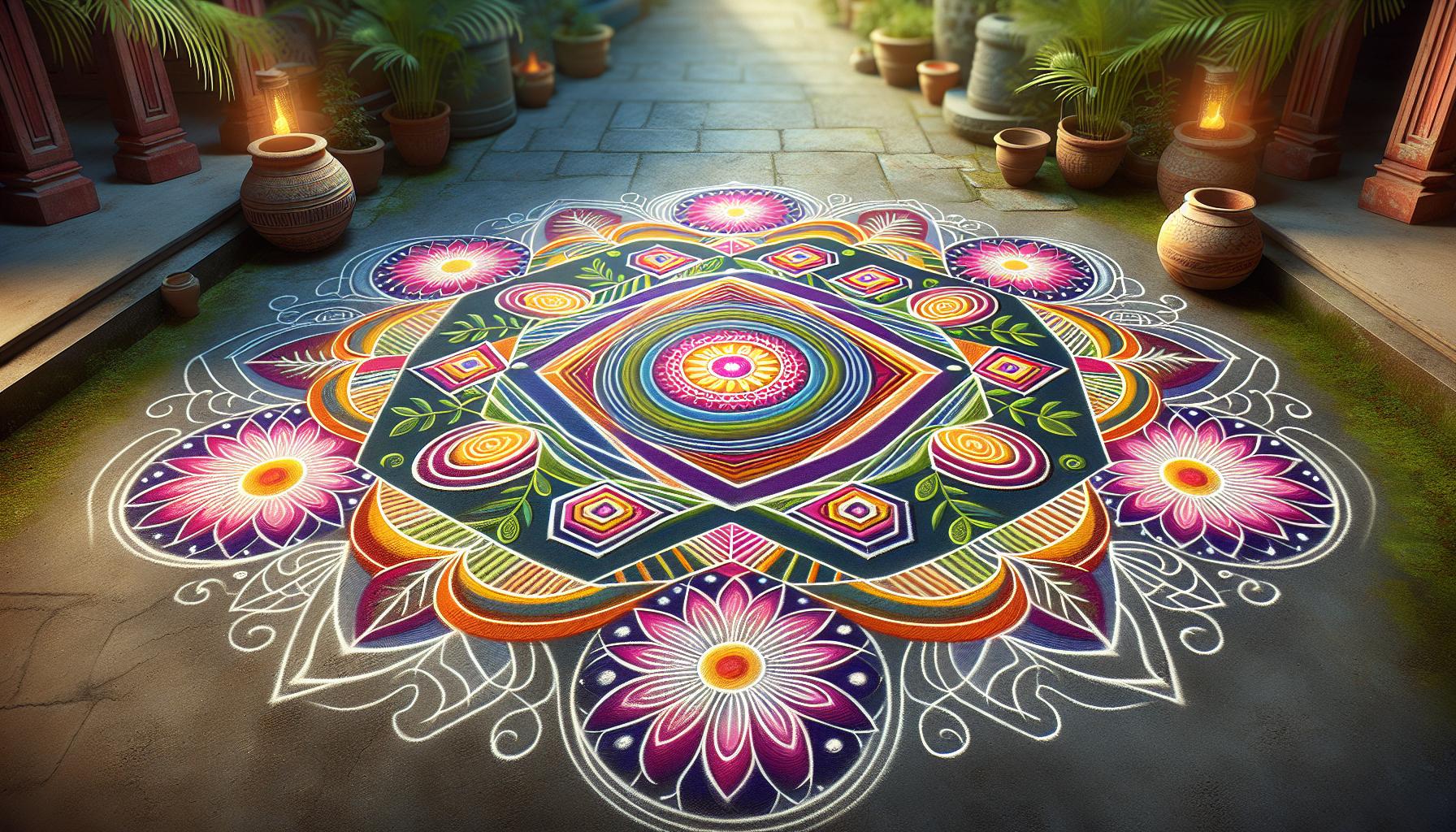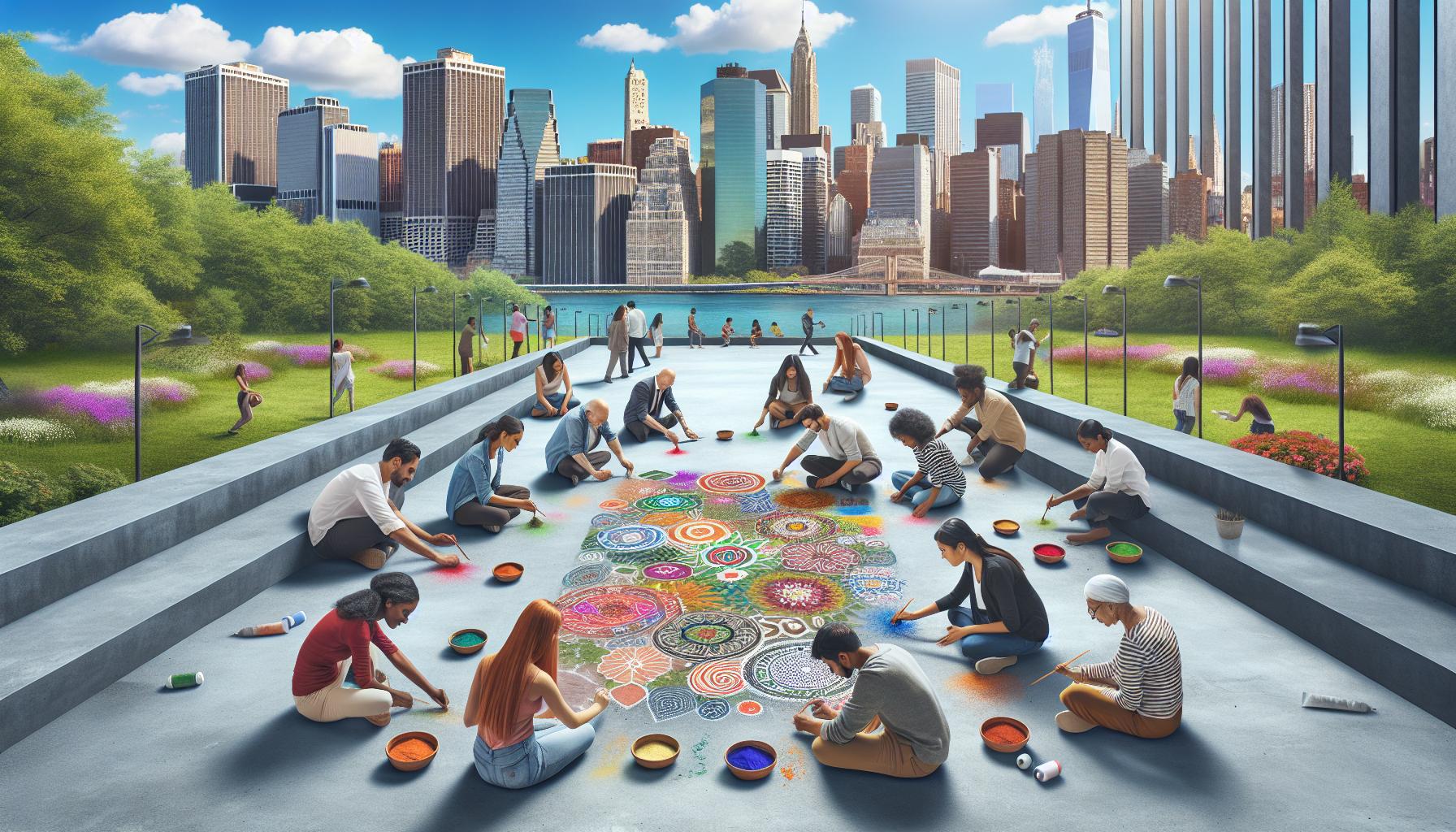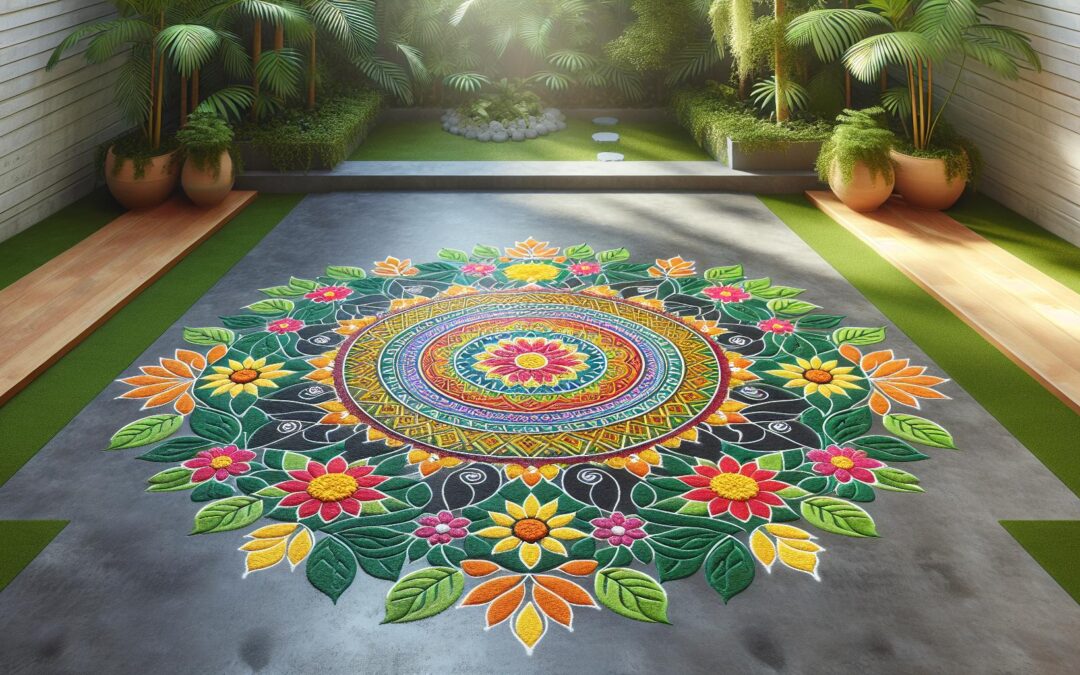Rangoli, the vibrant art of creating intricate patterns on floors, has been a cherished tradition in Indian culture for centuries. I’ve always been fascinated by the beauty and significance of these colorful designs, especially the simpler ones that anyone can create.
In this article, I’ll explore some beautiful yet easy-to-make rangoli patterns that’ll add a touch of elegance to your home. Whether you’re a beginner or just looking for quick ideas, these simple designs are perfect for brightening up any space during festivals or special occasions. Let’s dive into the world of rangoli and discover how you can create stunning floor art with minimal effort and maximum impact.
Key Takeaways
- Simple rangoli designs combine traditional art with modern accessibility, using geometric shapes and floral motifs
- Essential materials include rangoli powder, rice flour, and eco-friendly alternatives like natural pigments and flower petals
- Circular and linear patterns form the basis for creating beautiful, easy-to-make rangoli designs
- Color combinations play a crucial role in enhancing rangoli’s visual appeal, from traditional schemes to bold contrasts
- Rangoli is displayed during various occasions, including religious festivals, weddings, and daily rituals
- Modern twists on rangoli incorporate innovative materials, geometric abstractions, and technology-inspired elements
Beautiful:p-Wqewuebky= Simple Rangoli Designs
Rangoli designs are colorful, intricate patterns created on floors or ground surfaces, typically using materials like colored rice, dry flour, colored sand, or flower petals. These vibrant artworks originate from the Indian subcontinent and hold deep cultural significance.
Rangoli patterns often feature:
- Geometric shapes
- Floral motifs
- Religious symbols
- Abstract designs
I’ve observed that rangoli designs serve multiple purposes:
- Welcoming guests and deities
- Decorating homes during festivals
- Bringing good luck and prosperity
- Expressing creativity and artistic skill
Traditional rangoli creation involves:
- Sketching an outline with chalk or white powder
- Filling in sections with various colors
- Adding intricate details and embellishments
Modern interpretations of rangoli include:
- Using eco-friendly materials
- Incorporating 3D elements
- Experimenting with unconventional color schemes
- Combining traditional and contemporary motifs
Rangoli designs vary in complexity, from simple geometric patterns to elaborate scenes depicting mythology or nature. I’ve found that even basic designs can create a stunning visual impact when executed with care and precision.
The Beauty of Simple Rangoli Patterns

Simple rangoli patterns capture the essence of this traditional art form while offering accessibility and elegance. These designs prove that beauty doesn’t always require complexity, often achieving stunning visual impact through minimalism and careful execution.
Geometric Shapes
Geometric shapes form the foundation of many simple yet striking rangoli designs. I’ve found that basic shapes like circles, squares, and triangles can be combined to create intricate patterns with minimal effort. For example:
- Concentric circles: Start with a small circle in the center and gradually increase the size outward
- Interlocking squares: Create a grid of squares, alternating colors for a mesmerizing effect
- Star patterns: Use straight lines to form multi-pointed stars, filling in sections with vibrant hues
- Diamond chains: Link diamond shapes to form a continuous border or central design
These geometric rangoli designs often require nothing more than a steady hand and basic tools like chalk or a thin brush. Their symmetry and precision make them visually appealing and perfect for beginners or those short on time.
Floral Motifs
Floral motifs offer a softer, more organic approach to simple rangoli patterns. I’ve discovered that even basic flower shapes can create stunning designs:
- Petal outlines: Draw simple petal shapes around a central point, leaving them unfilled for a delicate look
- Lotus designs: Create a stylized lotus flower using overlapping circles and tear-drop shapes
- Marigold patterns: Use small circles clustered together to mimic marigold flowers, a common element in Indian decor
- Leaf borders: Incorporate simple leaf shapes as borders or accents to frame your main design
These floral rangoli patterns often evoke a sense of natural beauty and grace. They’re particularly well-suited for festivals celebrating nature or spring, such as Pongal or Onam. By using just a few basic shapes and colors, it’s possible to create a rangoli that captures the essence of floral beauty without overwhelming complexity.
Materials Needed for Creating Rangoli

To create beautiful and simple rangoli designs, I’ll need a few essential materials. Here’s a list of items that are commonly used:
- Rangoli powder: Colored, fine powder specifically made for rangoli
- Rice flour: White, finely ground rice powder for outlines
- Chalk: For sketching initial designs on the floor
- Stencils: Pre-made patterns for easier tracing
- Sieve: To sprinkle powder evenly
- Small spoons: For precise powder application
- Brushes: Various sizes for filling in colors
- Ruler or string: To create straight lines and symmetrical shapes
- Flower petals: For natural color and texture
- Diyas or candles: To add illumination to the design
For eco-friendly alternatives, I can use:
- Natural pigments: Turmeric (yellow), kumkum (red), coffee grounds (brown)
- Colored sand: Reusable and easy to clean up
- Flower petals and leaves: For a biodegradable option
Here’s a table comparing the pros and cons of different rangoli materials:
| Material | Pros | Cons |
|---|---|---|
| Rangoli powder | Vibrant colors, easy to use | Can be messy, may stain |
| Rice flour | Eco-friendly, readily available | Limited color options |
| Flower petals | Natural, fragrant | May wilt quickly |
| Colored sand | Reusable, easy cleanup | Less traditional |
| Natural pigments | Safe, eco-friendly | May have muted colors |
By choosing the right materials, I can create stunning rangoli designs while considering factors like eco-friendliness, availability, and ease of use.
Step-by-Step Guide to Making Simple Rangoli Designs

Creating simple rangoli designs is an enjoyable and rewarding process that anyone can master with a little practice. I’ll guide you through two popular types of rangoli patterns: circular designs and linear patterns.
Circular Designs
Circular rangoli designs are classic and versatile. To create a basic circular design:
- Draw a central dot using chalk or rangoli powder.
- Create concentric circles around the central point using a string or compass.
- Divide the circles into equal sections with straight lines.
- Fill in alternate sections with different colors or patterns.
- Add decorative elements like dots, swirls, or petals between the sections.
For more intricate circular designs:
- Use a stencil to create perfect circles.
- Incorporate spiral patterns within the circles.
- Add smaller circles at the intersections of lines.
- Create a mandala-like effect by repeating patterns symmetrically.
Linear Patterns
Linear rangoli designs are straightforward and ideal for doorways or long spaces. To create a basic linear pattern:
- Draw two parallel lines as a guide.
- Create a repeating pattern within these lines (e.g., zigzags, waves, or geometric shapes).
- Add symmetrical elements on both sides of the central pattern.
- Fill in the design with colors, starting from the center and moving outwards.
- Enhance the borders with dots or small motifs.
For more complex linear designs:
- Combine multiple linear patterns to create a wider rangoli.
- Incorporate diagonal lines for added visual interest.
- Use contrasting colors to make the pattern pop.
- Add floral or leaf motifs along the edges.
By mastering these circular and linear patterns, you’ll have a solid foundation for creating beautiful, simple rangoli designs for any occasion.
Color Combinations for Stunning Rangoli
When creating rangoli designs, color combinations play a crucial role in achieving a visually striking effect. I’ll share some popular and eye-catching color pairings that elevate simple rangoli patterns to stunning works of art.
Traditional Color Schemes
Traditional rangoli color schemes often draw inspiration from nature and cultural symbolism:
- Red and Yellow: Symbolizes prosperity and auspiciousness
- Green and Orange: Represents growth and energy
- Blue and White: Evokes serenity and purity
- Purple and Gold: Conveys royalty and luxury
Monochromatic Elegance
Monochromatic color schemes use variations of a single hue:
- Shades of Blue: From light sky blue to deep navy
- Reds: Ranging from pale pink to rich crimson
- Greens: From soft mint to deep forest green
Complementary Contrasts
Complementary colors create vibrant, high-contrast designs:
- Purple and Yellow
- Blue and Orange
- Red and Green
Pastel Harmony
Soft, muted colors create a gentle and soothing rangoli:
- Pale Pink and Mint Green
- Light Blue and Lavender
- Peach and Soft Yellow
Bold and Bright
For a festive and energetic rangoli, consider these bold combinations:
- Magenta and Turquoise
- Electric Blue and Neon Yellow
- Bright Orange and Deep Purple
Nature-Inspired Palettes
Draw inspiration from natural elements:
- Earth Tones: Browns, Greens, and Ochres
- Ocean Hues: Blues, Teals, and Sandy Beiges
- Sunset Colors: Oranges, Pinks, and Purples
- Use odd numbers of colors for balanced designs
- Incorporate white or black to define patterns
- Consider the background color when selecting your palette
- Test color combinations before committing to the final design
By experimenting with these color combinations, you’ll create rangoli designs that captivate and inspire. Remember, the key to stunning rangoli lies in harmonious color selection and thoughtful application.
Occasions for Displaying Rangoli Art
Rangoli art graces Indian homes and public spaces during various celebrations and events. Here are some key occasions when you’ll find these beautiful patterns adorning floors and entrances:
Religious Festivals
During major Hindu festivals, rangoli becomes an integral part of the celebrations:
- Diwali: Intricate designs welcome Goddess Lakshmi
- Pongal: Kolam patterns decorate courtyards
- Onam: Pookalam flower rangolis create vibrant displays
- Ganesh Chaturthi: Colorful designs honor Lord Ganesha
Weddings and Ceremonies
Rangoli adds auspicious beauty to important life events:
- Wedding venues: Elaborate designs at entrances and mandaps
- Housewarming ceremonies: Welcoming patterns for new homes
- Baby showers: Colorful designs celebrating new life
- Engagement parties: Artistic floor decorations for joyous occasions
Daily Rituals
In many households, simpler rangoli designs are part of daily life:
- Morning routines: Small patterns at doorsteps
- Prayer areas: Subtle designs near home altars
- Kitchen entrances: Simple kolams for cleanliness and positivity
Cultural Events
Rangoli showcases artistic traditions at various cultural gatherings:
- Art exhibitions: Displays of intricate rangoli designs
- School competitions: Students showcase creativity through rangoli
- Community festivals: Large-scale rangoli installations in public spaces
Special Occasions
Rangoli adds a touch of festivity to personal and social events:
- Birthdays: Colorful designs to mark celebratory days
- Anniversaries: Romantic patterns for couples
- Dinner parties: Elegant designs to welcome guests
- New Year celebrations: Auspicious patterns for fresh beginnings
By understanding these occasions, you can create appropriate rangoli designs that enhance the significance of each event and add to the festive atmosphere.
Modern Twists on Traditional Rangoli
Traditional rangoli designs are evolving with contemporary influences, creating exciting new interpretations. I’ve seen several innovative approaches that blend classic elements with modern aesthetics:
Fusion of Materials
Modern rangoli artists are experimenting with unconventional materials:
- Metallic powders for a shimmering effect
- LED lights integrated into designs for nighttime displays
- Recyclable materials like colored paper or fabric scraps
- 3D elements using clay or paper mache
Geometric Abstractions
Contemporary rangoli often features bold geometric patterns:
- Minimalist designs with clean lines and sharp angles
- Optical illusions created through clever use of shapes
- Mandala-inspired patterns with intricate details
- Asymmetrical layouts that challenge traditional symmetry
Technology-Inspired Designs
Digital age influences are apparent in modern rangoli:
- QR code rangolis that scan to reveal messages or links
- Pixel art interpretations of classic motifs
- Designs inspired by circuit boards or computer chips
- Augmented reality rangolis that come to life through smartphone apps
Global Fusion
Modern artists are incorporating international elements:
- Combining rangoli with other cultural art forms like Celtic knots
- Integrating global symbols and icons into traditional patterns
- Creating map-inspired designs to represent unity and diversity
- Fusing rangoli techniques with street art styles
Eco-Friendly Innovations
Sustainability is a key focus in contemporary rangoli:
- Using biodegradable materials like colored sand or flower petals
- Creating rangolis with seeds that grow into plants
- Upcycling household items to form temporary installations
- Water-based designs that evaporate, leaving no trace
These modern twists on traditional rangoli demonstrate the art form’s adaptability and enduring appeal. By embracing new ideas while respecting cultural roots, artists are ensuring rangoli remains relevant and captivating for future generations.
Beautiful simple rangoli designs offer a perfect blend of tradition and accessibility. They allow anyone to create stunning floor art without extensive training or time commitment. By exploring geometric shapes floral motifs and experimenting with color combinations we can all tap into this rich cultural tradition. Whether for festivals special occasions or daily rituals these designs bring joy and meaning to our spaces. As rangoli evolves with modern twists it remains a vibrant art form adaptable to contemporary tastes while honoring its roots. I hope this guide inspires you to try your hand at creating these beautiful patterns celebrating creativity and cultural heritage in your home.
Our super author here at Famous Parenting and an absolute wealth of knowledge. She has studied many topics including creative writing, psychology and journalism but her real passion lies in raising her 3 children. Between working from home, homeschooling her youngest 2 children and navigating the world of teenagers she is a guru for parents.





